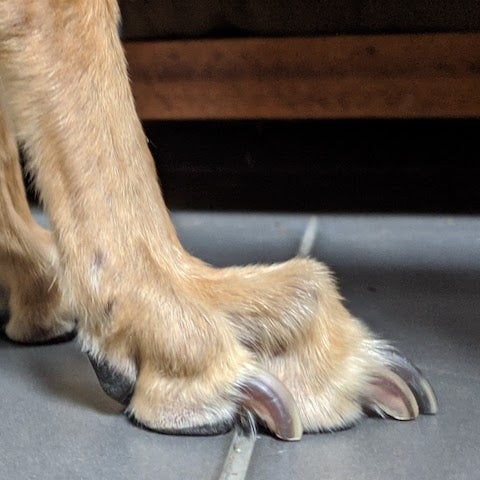GRIT - the unseen enemy

Grit is very common in Greyhounds who live in urban environments and walk terrestrial pavements.
Dr Bec Goode at Port Phillip Animal Hospital reports they actually see more grit cases each week than corns. They are awfully painful for the dog, and difficult to treat with good outcomes in many Greyhounds. Mindful prevention is far better than the cure.
Why Greyhounds?
Grit is a common presentation to veterinary clinics in retired greyhounds, largely because of their soft padded feet. their thin pad tissue combined with a lack of pad fat means they are prone to foreign body penetration. Hunny was recently admitted for suspected grit on top of her continuing treatment for her corns, but luckily Hunny's grit was very superficial and they managed to flick it out with a needle tip.

in this x-ray of Hunny's paw, you can see the grit (circled) is tiny, but enough to cause her to be lame.
How can you tell if there's grit imbedded in your Greyhound's foot?
You'll probably notice that your Greyhound is lame, limping or favouring other feet. On close inspection, you may see pad damage such as a small wound or a hole. If you apply gentle pressure, your Greyhound may experience obvious discomfort. The only way to reliably confirm it's grit is to have the foot x-rayed from two views.

These three x-rays illustrate how some grit can be large and singular, while others present as many small fragments making their removal time-consuming and complicated.
How is it treated?
Grit has to be confirmed and surgically removed. Often with local anaesthetic and sedation, and in extreme cases with general anaesthetic. This sounds like it would be straightforward but is very tricky, and can result in a lot of damage to the structures in the pad, post-operative infections and sometimes, if people don't protect the paw for long enough, more grit in the healing wound. Dr Bec describes it as "trying to find a needle in a haystack".
In early cases where the grit is visible poultices can be effective, but x-ray diagnosis is recommended to ensure there is not a deeper issue.
Greyhounds are generally treated with antibiotics, pain relief and bandage changes for weeks following surgery. Sometimes, with chronic problems they will recommend flexor tenotomy or even toe amputation. So you can see how serious it is; all from a tiny bit of grit you can barely see.

Is there a prevention?
A prevention is always better than the cure. Dr Bec recommends boots for soft padded Greyhounds, to always clean paws after walks and to be observant on new walking surfaces.

Rationale, x-rays, treatment and advice kindly provided by Dr Rebecca Goode, Port Phillip Animal Hospital



